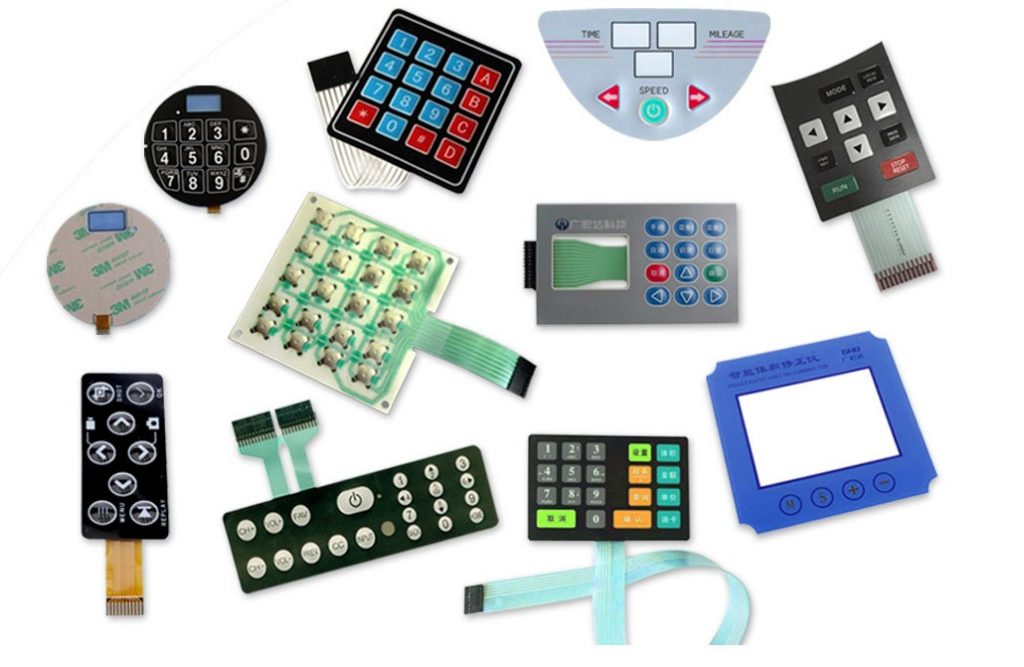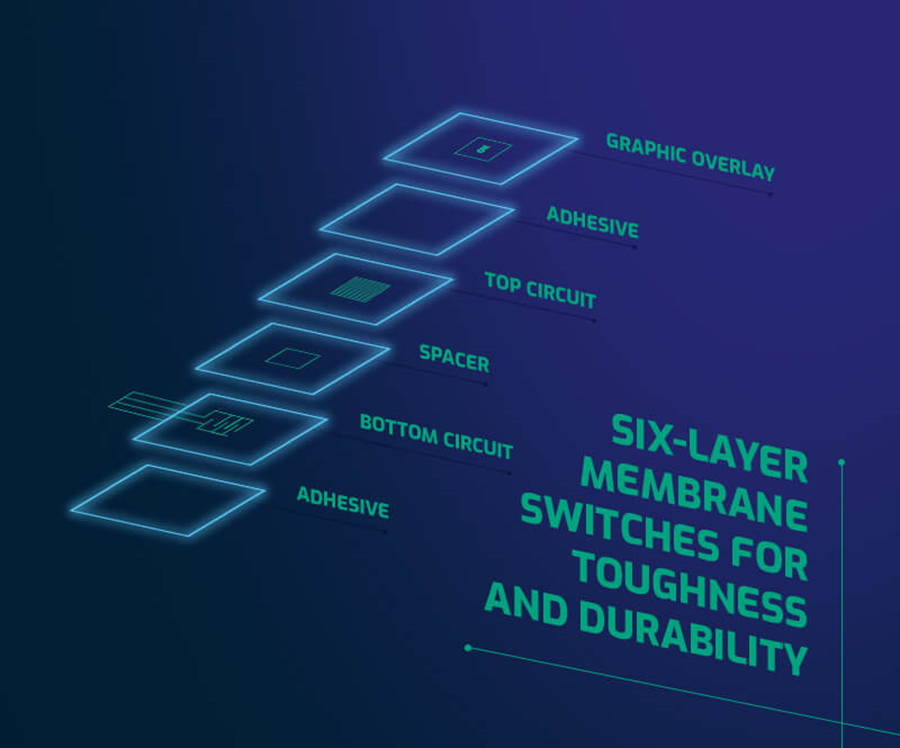Why membrane switch is helping streamline industrial workflows
Recognizing the Significance of Membrane Layer Switch Over in Modern Electronic Devices
Membrane switches are indispensable components in modern digital gadgets. They provide a mix of capability and design that boosts customer interaction. Their light-weight and durable nature makes them appropriate for numerous applications. As industries evolve, the need for modification and progressed functions expands. Recognizing exactly how membrane layer switches over add to innovation discloses their importance in shaping the future of electronic devices. What lies in advance for this innovation?
The Basics of Membrane Layer Switch Over Technology
Although commonly forgotten, membrane button modern technology plays a necessary role in the contemporary electronic devices landscape - membrane switch. These tools, made up of numerous layers, act as customer interfaces for different electronic items, ranging from household appliances to medical equipment. A normal membrane button contains a visuals overlay, a spacer layer, and a circuit layer, which are thoroughly set up to develop a practical interface.When pressure is put on the overlay, the circuit layer is completed, enabling signals to be transferred to the gadget. This technology is understood for its convenience, making it possible for customization in capability, design, and form to meet certain user requirements. Furthermore, membrane layer switches are lightweight and slim, making them ideal for applications where space is a premium. Their resilience and resistance to ecological elements better improve their charm, guaranteeing they can stand up to rough conditions while preserving capability. On the whole, membrane layer button modern technology is indispensable to developing user-friendly and effective digital tools

Trick Advantages of Membrane Layer Switches Over
Membrane layer changes deal several essential advantages that make them a recommended choice in numerous digital applications. Their design permits for a small form element, allowing makers to create streamlined and lightweight devices. Furthermore, membrane switches are immune to dust, wetness, and chemicals, which boosts their longevity and long life sought after atmospheres. The responsive feedback supplied by these switches can improve individual experience, making them intuitive and easy to operate.Furthermore, membrane switches can be customized with diverse graphics and shades, enabling special branding chances. The production procedure is normally cost-efficient, particularly for high-volume manufacturing, as it reduces setting up time and simplifies layout. Finally, membrane switches need very little upkeep, contributing to reduced total operational costs. These benefits highlight their expanding popularity in modern electronics, where integrity and straightforward interfaces are vital.

Applications Across Numerous Industries
The adaptability of membrane switches allows their widespread adoption throughout different industries. In the clinical area, they are generally used in diagnostic tools and individual monitoring systems, providing a resilient user interface resistant to impurities. The vehicle sector uses membrane layer buttons for dashboard controls, improving individual experience with sleek layouts that stand up to extreme problems. In consumer electronic devices, they work as control board for tools such as microwaves and coffee machine, offering an easy to use interface that is easy to tidy. The aerospace sector employs membrane layer buttons in cockpit controls, where dependability and area efficiency are paramount. Furthermore, the industrial market leverages these buttons in machinery and control systems to assure durable operation in requiring atmospheres. This wide array of applications underscores the versatility of membrane layer buttons, making them integral components in boosting performance and user communication across varied technological landscapes.
Modification and Design Flexibility

Future Trends in Membrane Change Growth
Emerging trends in membrane layer switch growth suggest an expanding emphasis on enhanced capability and combination with clever technologies. As consumer demand for extra sophisticated digital tools boosts, makers are focusing on developing membrane changes that not only serve basic operational roles yet also include attributes like touch sensitivity, backlighting, and haptic feedback.Furthermore, developments in materials are expected to enhance longevity and environmental resistance, making membrane switches appropriate for diverse applications in markets such as health care, auto, and customer electronic devices. The assimilation of capacitive touch technology is likely to end up being more widespread, permitting for sleeker styles and enhanced customer interfaces. membrane switch.Additionally, the rise of the Net of Things (IoT) is triggering the development of membrane layer changes that can interact wirelessly with various other gadgets, improving interconnectivity. On the whole, the future of membrane layer switch technology shows up promising, driven by technology and the search of easy to use services
Often Asked Questions
Exactly How Do Membrane Layer Switches Compare to Typical Mechanical Buttons?
Membrane layer switches, being much more space-efficient and supplying a streamlined layout, contrast with traditional mechanical buttons that give responsive responses. The former commonly feature customizable graphics, while the last commonly assure toughness and integrity in various applications.
What Materials Are Generally Utilized in Membrane Layer Switch Manufacturing?
Membrane layer buttons are generally created utilizing products such as polyester, polycarbonate, and published conductive inks. These materials provide versatility, sturdiness, weblink and responsiveness, making them suitable for numerous applications in digital gadgets and user interfaces.
Can Membrane Layer Switches Be Repaired or Reused?
Membrane buttons can frequently be repaired, particularly if small concerns develop, such as adhesive failure or surface area damages. Nonetheless, complete reuse is normally restricted due to wear and prospective degradation of products in time.
How Do Ecological Elements Impact Membrane Layer Change Efficiency?
Environmental elements, such as moisture, exposure, and temperature to chemicals, significantly affect membrane switch efficiency. Severe conditions can cause deterioration, affecting responsiveness and longevity, eventually jeopardizing the capability of the tool in numerous applications.
What Is the Normal Lifespan of a Membrane Layer Switch over?
The regular life expectancy of a membrane layer switch generally varies from 1 to 5 million actuations, depending on variables such as use regularity, ecological conditions, and the products utilized in manufacturing, influencing sturdiness and performance longevity. A normal membrane layer switch consists of a visuals overlay, a spacer layer, and a circuit layer, which are meticulously put together to produce a useful interface - membrane switch.When stress is applied to the overlay, the circuit layer is completed, enabling signals to be transmitted to the tool. The tactile comments given by these buttons can enhance user experience, making them user-friendly and very easy to operate.Furthermore, membrane switches can be customized with diverse graphics and colors, allowing for distinct branding chances. As customer need for a lot more innovative digital tools rises, suppliers are concentrating on developing membrane layer switches over that not just offer fundamental functional functions however likewise incorporate features like touch sensitivity, backlighting, and haptic feedback.Furthermore, developments in materials are anticipated to improve sturdiness her latest blog and environmental resistance, making membrane layer switches over suitable for varied applications in industries such as health care, vehicle, and consumer electronics. The combination of capacitive touch modern technology is most likely to end up being much more prevalent, allowing for sleeker layouts and enhanced individual interfaces.Additionally, the increase of the Web of Things (IoT) is prompting the development of membrane layer changes that can communicate wirelessly with various other gadgets, improving interconnectivity. Membrane buttons, being much more space-efficient and offering a streamlined style, contrast with typical mechanical switches that provide responsive comments